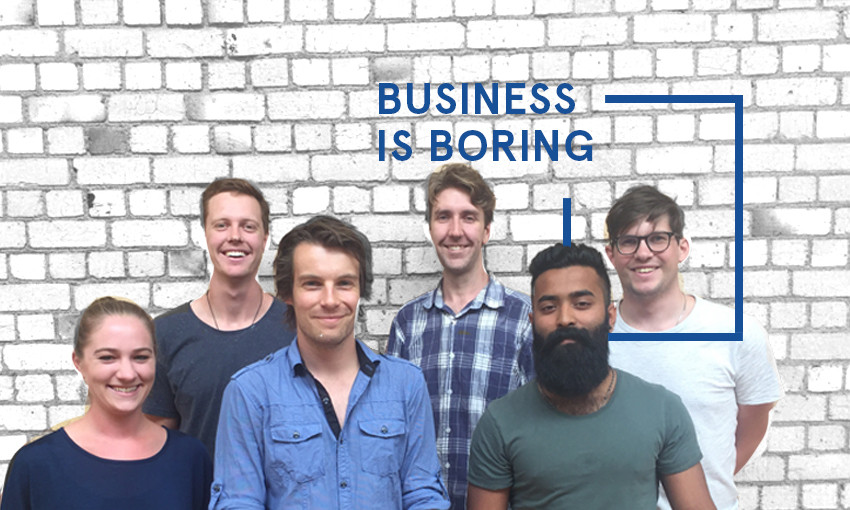Business is Boring is a weekly podcast series presented by The Spinoff in association with Vodafone Xone. Host Simon Pound speaks with innovators and commentators focused on the future of New Zealand, with the interview available as both audio and a transcribed excerpt. This week Simon talks to Ben Reynolds about how his company Spalk is making sports commentary more accessible.

Have you ever turned on your favorite live sports game to be disappointed by the commentators? Maybe it is an Aussie butchering Māori or Pasifika names, maybe it is just that they are talking out of their hats.
Well, Ben Reynolds and Michael Prendergast did something about it. They used internet software to do their own commentaries, growing to thousands of fans who would tune in despite audio delays, lags from live action and all sorts of technical shortcomings – shortcomings in which they saw an opportunity.
So they built the perfect system to allow multiple commentaries on a single stream of video.
They prototyped, launched and have now built the tool into Spalk, a service that has let millions view video with their audio and is used by Māori TV, FIBA and soon lots of American sports outfits to allow choice for viewers and savings for broadcasters.
It’s an idea driving up viewership, engagement and getting backing from capital. It’s earned them a place at the Vodafone Xone accelerator that kick-started their growth. To talk the journey so far and the plans ahead, Ben Reynolds joined the podcast.
You started out with the idea of providing alternate commentary for sports, pretty much for fun. Did you see pretty soon that there were actually people whose home team was playing and they weren’t getting their side of the story out?
Yeah, exactly, so what we did after we built this little hacky version of Spalk was we went out and said to a bunch of amateur sports organisations, hey, you’re not actually streaming anything, can we put some of your content online so us and our friends can commentate it?
So our first partner was Auckland Cricket, who streamed a bunch of their Plunket Shield matches and a bunch of their county level cricket games, and so we’d be sitting there with a camcorder following the action on the side of the field, streaming it to YouTube, it would go onto our system, and then people would be commentating it from all around New Zealand.
Soon we had a commentator in Australia, and then one in London. The commentators were growing and growing. We started doing a lot of work with other amateur sports organisations, the likes of New Zealand Swimming and New Zealand Squash and a lot of those other sports who weren’t quite at the broadcast stage but were really keen to get content online so their fans could commentate it.
We were getting good numbers of people tuning in and listening to all this good commentary. We had professional players coming on and commentating tournaments, and kids who’d just finished up at their high school champs coming on to commentate their friends and all sorts of things like that.
We started seeing a lot of grassroots people coming in and getting really really excited about what we were doing.
Did you have to build out the infrastructure to actually film everything and live stream it in order to get the Spalk idea off the ground?
It was interesting, at that stage we didn’t really think that places like SkyTV or Māori Television who are one of our really good partners now would ever take us seriously. So we said to ourselves, what’s the easiest way that we can get access to some content? And the easiest way was to just do it ourselves.
I borrowed a camcorder from Mum and Dad and figured out how to stream everything online and it was a pretty hacky setup with a camcorder on the side of the pitch and me sitting there texting scores through to the commentators so that they could give score updates because there was no score graphic or anything up on the screen.
We got the numbers and that really validated that we had a kernel of something interesting.
With that kernel you then went to Māori TV who were one of your first big broadcast partners. Was that driven by the horrendous mispronunciations of Māori and Pasifika names you hear?
Yeah that was part of it. It’s funny because they actually ended up coming to us. They got in touch and said hey, we’ve seen what you guys are doing and think it’s really interesting from the ability to have multiple different languages.
Obviously as a state broadcaster they’ve got to provide a certain level of coverage in te reo Māori so for them it was a really easy way to say here’s a really easy way to do English commentary, Māori commentary, and hey, if we want to throw in Fijian and Samoan and a variety of other Pasifika languages so we’ve got a really broad broadcast and a really appealing product to different demographics around New Zealand.
Really for them it was where they saw the use case and so for us what it meant was we had to go back and rejig our entire infrastructure to be able to deal with being on a product like Māori Television.
Rather than dealing with a camcorder, suddenly we were on broadcast-level content coming out of the New Zealand High School Basketball champs, and we’ve got a certain level of service that we’ve got to provide, and so it was a really good opportunity for us to go and build a proper product and take the time to go and do a bit more research and development and really mature where the product was at.
